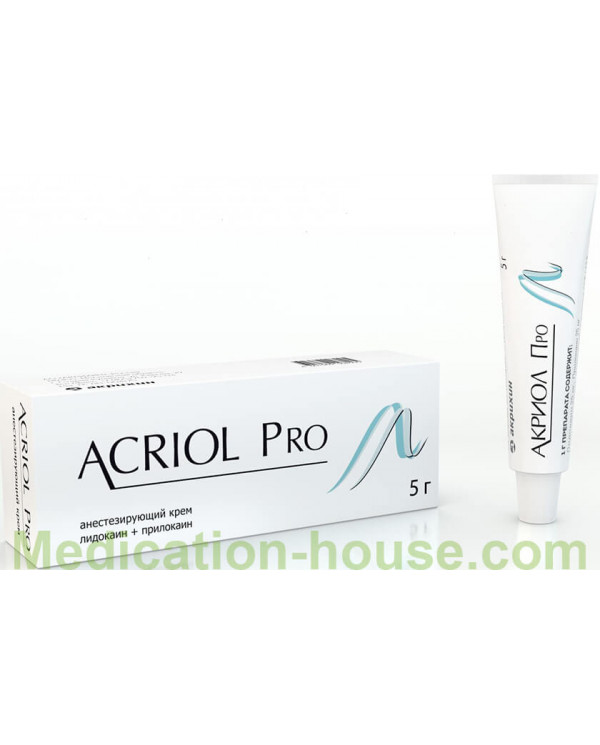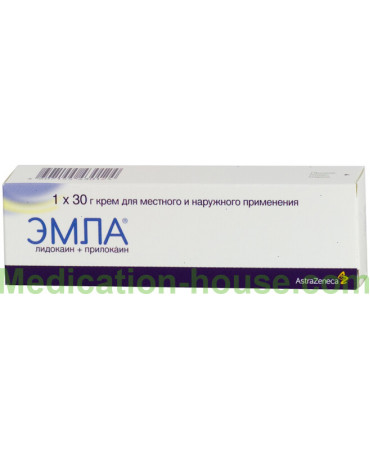Acriol Pro instruction
You can buy Acriol Pro cream here
The combination of lidocaine 2.5% + prilocaine 2.5% significantly reduces pain during the following cosmetic procedures:
mesotherapy
botulinum therapy
contour plastics
laser treatments
tattoo
epilation, especially in areas with thin sensitive skin
The combination of local anesthetics used reduces the risk of developing inflammation.
Acriol Pro - medicinal anesthetic cream for pharmaceutical quality skin at an affordable price.
Modern cosmetology is able to compete at a high level with plastic surgery. Today, visitors to clinics and beauty salons have the opportunity to improve their appearance without surgical intervention. However, most of the “beauty procedures” are accompanied by pain that not every woman is willing and must endure.
In order to provide the patient with maximum comfort during cosmetic procedures, specialists use an anesthetic for the skin, which allows the necessary manipulations to be performed without causing discomfort to the weaker sex.
Benefits of Skin Anesthetics
Anesthetic for the skin is one of the popular painkillers in the cosmetology office. There are a huge number of such products on the cosmetology market, but not everyone performs their functions fully and can be considered effective and safe for use.
From a variety of options, you can select anesthetic cream Acriol Pro. The reason that it is recommended by cosmetologists are the following factors:
Local anesthetic cream belongs to the category of topical anesthetics for external use, which significantly reduces the risks of toxic reactions, which are not uncommon with the use of injection anesthetics. Manifestations of toxic reactions can be nausea, headaches, and at high doses - a drop in blood pressure, seizures.
Anesthetic cream contains 2 main anesthetic components in a 1: 1 ratio (lidocaine and prilocaine), which according to the results of numerous studies is the optimal combination for anesthetizing the skin.
Adequate cost makes the facility accessible to all.
The formula of Acriol Pro has an antibacterial and antifungal effect.
Skin anesthetic is approved for use even in infants, starting from the first day of life.
This anesthetic cream is a registered drug that guarantees compliance with the composition of Acriol Pro stated in the instructions and the availability of information in the instructions about dosages and contraindications, which affects the safety of its use.
Thanks to the above qualities, Acriol Pro is the choice of many cosmetologists. It has a high lipid solubility, binds well with proteins in nerve cells and with plasma albumin. These qualities directly affect the power and duration of its analgesic effect and reduce the risks of a serious impact on the central nervous system, provided that the recommended doses and areas of application are observed.
Lidocaine and prilocaine strengthen each other
Lidocaine is an anesthetic that originated from the evolution of painkillers in 1943. It was developed by N. Lofgren. This drug is quite effective when applied topically on the mucous membranes, but not effective enough when applied externally on the skin. To enhance the analgesic effect, scientists raised the concentration of lidocaine in ointments up to 40%, but did not achieve a good effect. At the same time, patients had moderate toxic reactions13. Lidocaine reduces the severity of pain, but has a number of negative effects on the central nervous system and toxic effects on the body when used in high concentrations. Lidocaine in concentrations from 0.5 to 4% has antifungal, antiviral and antibacterial effects4.
Prilocaine is an anesthetic similar in effect to lidocaine, but with less systemic toxicity. In combination with lidocaine, it forms a special compound - an eutectic mixture, which numb the skin much more effectively than each of the components separately.
"Acriol Pro" contains in its composition 2 active substances in equal proportions (lidocaine 2.5% and prilocaine 2.5%), which together is the ideal ratio for skin anesthesia. The choice of this concentration is due to the fact that a further increase in the concentration in this cream does not lead to increased analgesic action. However, the total concentration of active substance anesthetics in each oil drop of the cream reaches 80%, which makes it more effective than single component anesthetics .
Thus, the scientifically based composition "Acriol Pro" makes this anesthetic cream optimal for use in cosmetology.
Release form, packaging and composition
Cream for local and external use in the form of a homogeneous mass of white or almost white color; a slight peculiar smell is allowed.
100 g
lidocaine 2.5g
prilokain 2.5 g
Excipients: PEG-54 hydrogenated castor oil - 1.9 g, carbomer - 1 g, sodium hydroxide - 0.52 g, purified water - up to 100 g
5 g - aluminum tubes (1) - cardboard packs.
30 g - aluminum tubes (1) - cardboard packs.
100 g - aluminum tubes (1) - cardboard packs.
Clinico-pharmacological group: A drug for surface anesthesia of the skin and mucous genital organs
Pharmaco-therapeutic group: Local anesthetic agent
pharmachologic effect
Combined local anesthetic for external and local use. Contains lidocaine and prilocaine, which are amide-type local anesthetics. Anesthesia of the skin is caused by the penetration of lidocaine and prilocaine into the layers of the epidermis and dermis. When applied to the mucous membrane of the genital organs, anesthesia is achieved faster than when applied to intact skin due to faster absorption of the active substances. The degree of anesthesia depends on the dose and duration of application.
Pharmacokinetics
Systemic absorption of active substances depends on the dose, duration of application and thickness of the skin (depending on the area of the body), as well as other features of the skin, such as skin diseases and shaving. When applied to the ulcerative surface of the lower extremities, the peculiarities of ulcers may influence the absorption of active substances, for example, the magnitude (with an increase in the ulcer area, the absorption increases).
Intact skin. In adults, after applying the amount of Acriol Pro containing this combination, in a single dose for 3 hours, systemic absorption of lidocaine was approximately 3% and prilocaine - 5%. Suction is slow. Cmax of lidocaine (average value of 0.12 μg / ml) and prilocain (average value of 0.07 μg / ml) in the blood plasma was reached after approximately 4 hours from the moment of application. The risk of toxic symptoms exists only when the concentration of active substances in the blood plasma is 5-10 μg / ml.
Trophic ulcers of the lower extremities. The time to reach Cmax of lidocaine (0.05-0.84 µg / ml) and prilocain (0.02-0.08 µg / ml) in the blood plasma is 1-2.5 hours from the moment of application of Acriol Pro on the ulcer surface for 30 minutes.
With repeated application to the ulcerative surface, cumulation in the blood plasma of prilocain, lidocaine or their metabolites was not observed.
The mucous membrane of the genitals. The time to Cmax of lidocaine and prilocain in plasma (average 0.18 µg / ml and 0.15 µg / ml, respectively) is approximately 35 minutes from the time of application to the vaginal mucosa for 10 minutes.
Indications of Acriol Pro
In adults, superficial anesthesia of the skin during injections (including vaccination), punctures and vascular catheterization, and superficial surgical procedures, including small cosmetic procedures and epilation; surface anesthesia of trophic ulcers of the lower extremities during surgical treatment (mechanical cleaning), for example, to remove fibrin, pus and necrotic tissues; surface anesthesia of the mucous membrane of the genital organs before carrying out painful manipulations and for pain relief before injections of local anesthetics.
In children: superficial anesthesia of the skin during injections (including vaccination), puncture and vascular catheterization and surface surgery (including removal of molluscum contagiosum).
Dosing regimen
Outwardly on the skin, locally - on the mucous membrane of the genital organs.
The dose and time of application are determined depending on the evidence, the clinical situation and the age of the patient.
Side effects of Acriol Pro
Local reactions: in the area of application transient local reactions are possible, such as pallor, redness and swelling; at the first moment after application - a slight burning sensation, itching and a sensation of heat. Hemorrhagic rash or point hemorrhages, especially after prolonged application in children with atopic dermatitis or molluscum contagiosum.
Corneal irritation due to accidental ingestion of Acriol Pro in the eyes.
General reactions: allergic reactions, in the most severe cases - anaphylactic shock. Methemoglobinemia and / or cyanosis.
Contraindications
Premature newborns born with a gestation period of less than 37 weeks; newborns weighing less than 3 kg; hypersensitivity to local amide anesthetics.
Use during pregnancy and lactation
In the course of research in animals, no direct or indirect negative effect of Acriol Pro on pregnancy, fetal development, on the process of childbirth or postnatal development was detected. Lidocaine and prilocaine penetrate the placental barrier and can be absorbed in the tissues of the fetus. No specific disorders of the reproductive process, such as an increase in the frequency of malformations or other direct or indirect adverse effects on the fetus, have been reported.
Lidocaine and prilocaine are excreted in breast milk in amounts that do not represent a risk to the child, when using drugs containing this combination, according to the indications in the recommended doses.
special instructions
With care: glucose-6-phosphate dehydrogenase deficiency, hereditary or idiopathic methemoglobinemia, widespread neurodermatitis (atopic dermatitis), patients taking class III antiarrhythmic drugs (eg, amiodarone).
Patients with glucose-6-phosphate dehydrogenase deficiency or hereditary or idiopathic methemoglobinemia are more susceptible to drug-dependent methemoglobinemia.
Care must be taken in the case of application of Acriol Pro on the skin with atopic dermatitis; time of application should be reduced (15-30 min).
Patients taking class III antiarrhythmic drugs (for example, amiodarone) should be under constant monitoring and ECG monitoring, since may affect the heart activity.
Do not put Acriol Pro on the damaged eardrum or in other cases, the possible penetration of the drug in the middle ear.
It is not necessary to put the preparation containing this combination on open wounds.
Lidocaine and prilocaine in concentrations above 0.5-2% have bactericidal and antiviral properties. In this regard, it is recommended to pay special attention when using Acriol Pro before s / c administration of a live vaccine (for example, BCG).
Due to lack of data on absorption, it is not recommended to apply to the mucous membrane of the genital organs in children.
Drug interactions
In patients receiving drugs that induce the development of methemoglobinemia (for example, drugs containing a sulfo group), the use of drugs containing this combination may increase the concentration of methemoglobin in the blood.
When treating with other local anesthetics and structurally similar drugs (including tocainide), the risk of increased systemic effects when using this combination in high doses should be taken into account.
Special studies to evaluate the interaction of lidocaine / prilocaine with class III antiarrhythmic drugs have not been carried out; care should be taken when using the drugs together.
Drugs that reduce clearance of lidocaine (for example, cimetidine or beta-blockers), can cause potentially toxic plasma concentrations when using repeated high doses of lidocaine for an extended period of time.
Terms of sell
You don't need a prescription to buy Acriol Pro.


